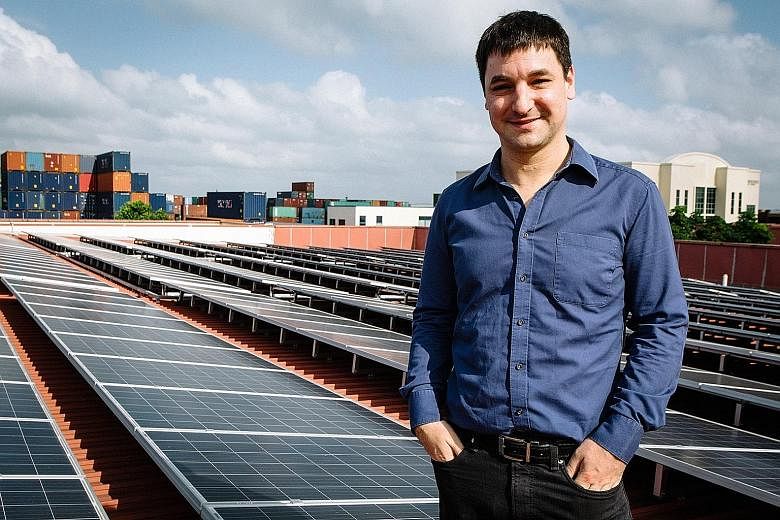Q What is your company about?
A We aim to transform how people in Singapore and other cities consume energy by connecting rooftop owners with consumers who want to buy solar energy. Rooftop owners can install solar panels and generate energy while tracking their contributions to their city in real time, and customers who buy the energy can monitor their usage on Sun Electric's platform.
Q How did Sun Electric come about?
A From 2009, I worked on solar research as a PhD student in physics at the National University of Singapore. In 2011, I finalised my thesis and, in 2012, consulted and worked in engineering sales - not only the design and technology, but also the commercial deals - and started to get new ideas.
In the deals we struck, we would approach building owners to install energy generators... The electricity would be connected through the building and we would try to have the building owner buy all that energy. But this was underwhelming to the owners. In some cases, the energy used is so large compared with the amount you can generate from the roof that the purchasing of clean energy seems a bit meaningless.
On the other hand, we could get a considerable amount of export, or excess electricity.
So you would be better off to engineer a smart solution for the distribution of electricity. At the same time, since I've been working in the solar sector, there was always a changing solar subsidy policy.
So when I had the vision of setting up this company in 2013, I wanted to create technologies for the solar sector that would allow us to enter a competitive energy market.
The vision of the firm was to go on two tracks - one is clean energy products which we can create. In a building, let's use smart metering and measurement systems that would empower us to create a commercial model, where the building doesn't get locked into these purchase agreements.
We set up our electricity retailing operations with the view that we can take all that electricity and pack it into clean energy products that can be purchased by people off site.
The other component we focused on was how to operate the energy generators.
We have a server, and all the generators are coupled to the server. That allows us to monitor, send commands and safely operate the system. Not only do we get the information to package the electricity, but we can also connect to the grid or optimise the generation of energy.
Q How has your company grown?
A There have been many important milestones. We started with limited funds - I pulled $40,000 in and set up the company and we raised an angel round.
In the first year, we worked on intellectual property (IP), trade name, design. We drafted patents for some of the systems we wanted to implement and were talking to the Government and the private sector, people with roof space.
Today, we are licensed, operating and delivering clean energy to customers.
Late last month, we announced the first live distribution of solar-generated electricity under the JTC- Spring test-bedding programme.
Seven consumers are now being served electricity from solar energy generators installed on JTC rooftops in Tuas South.
Now that the test-bedding has succeeded, we have another 20 buildings that have signed up to put the energy generators in, which gives us about $20 million in assets.
The buildings include schools, factories and warehouses, and we are in the middle of constructing generators for about 10 of them.
We've also founded Sun Electric in Delaware in the United States, which owns the company in Florida, Texas, California, Arizona, New Mexico and Nevada; and we're working on the licensing and legal framework. We're focusing on California and Texas at the moment.
We launched Sun Electric in the Philippines and are working with some partners with roof space. In Australia, we are focusing on New South Wales and intend to launch the company in Sydney.
Since we have created Sun Electric as a platform for cities, we are identifying which are good target cities to go in and implement this platform. We selected these cities based on their regulation of the energy market, how much sunlight they have, what is the pricing of energy there. Most are around the equator, in liberalised energy markets.
We have five employees, and work with consultants as well as construction and engineering firms.
It's been three years of building the company - we were writing software for over a year and are always adding new features. We have a two-year pipeline of things we have thought of in-house to add in.
Q What were the challenges along the way?
A There's always adversity to face in a competitive market. There are other solar players engaging in different ways, but I think we have also been the first to push through many regulations.
One of the things we grapple with is how to participate in tenders. If we are creating something unique, if we go into a tender we may lose some IP rights. But I think we also strike a balance. Whenever we think we are on to something new, we draft the patent with our lawyers and file it with the Intellectual Property Office here.
I think we are on track with a good idea, we are developing something the world needs.
I've never thought of us as small - I've thought that this is a good idea, it is something other people are not doing and it will work. So let's go and build it, and if we build it people will use it.


